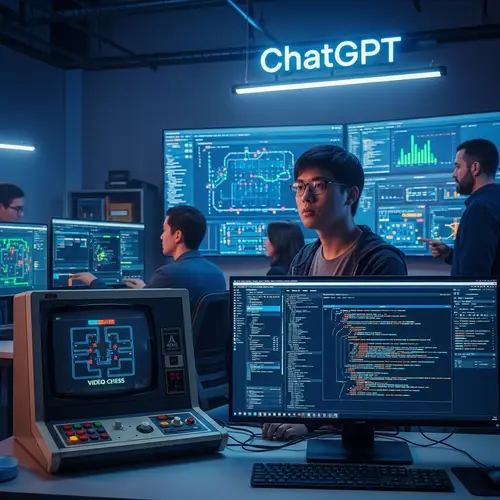ChatGPT has changed how we view artificial intelligence, to say the least. It’s everywhere — writing essays, answering customer service queries, even helping coders sort out bugs. But while it’s impressive in many ways, it’s far from perfect. A recent hiccup that caught many off guard involved a blast from the past: Atari’s Video Chess. Yep, the kind of retro game you’d expect a modern AI to beat with its eyes closed — if it had eyes.
So, what went down when this modern-day text engine met old-school programming genius? Keep reading, because this isn’t just a quirky contrast between old and new. It’s a revealing look into how ChatGPT performs in games, what its weak spots are, and why symbolic systems like Atari’s sometimes come out on top where today’s large language models (LLMs) get flat-out confused.
How Did ChatGPT Lose to Atari’s Video Chess?

Before we break it down, let’s make one thing clear. This isn’t a matter of one AI battling another in some dramatic tournament. No, this was more like a chess-based illustration involving ChatGPT attempting to play the game through text exchanges, responding to inputs and moves like a virtual opponent. Except… it didn’t go so well.
Even though you’d assume a tool this advanced could play a chess match from start to finish with finesse, that wasn’t quite the case. ChatGPT made some strange moves, misunderstood board states, and frankly got outplayed by a game released in 1979 built to run on the Atari 2600.
Not gonna lie, that’s pretty wild.
Here’s where it gets more interesting — this wasn’t about brute force, faster processors, or crazy advanced calculations (although those help). Atari’s Video Chess used symbolic decision trees and basic, efficient programming logic. And that approach? It turned out to be more accurate than the sprawling, token-loving language model that is ChatGPT when it came to chess.
What Really Went Wrong With ChatGPT?

LLM Memory: A Bit of a Wobbly Foundation
One of the key problems with LLMs — including ChatGPT — is the way they handle memory. Unlike focused engines that track every state of a game board meticulously, ChatGPT tends to lose track of details if they stretch too far back in a conversation.
So, in a match of chess, where your queen’s position five moves ago can be a game-changer today? Yeah, that’s an issue.
This is a big one when it comes to how LLMs understand structured games that demand strict rule-following and consistency. Despite all their dazzling outputs and seemingly endless knowledge, they sometimes forget the basics — like where a bishop ended up two turns ago. Honestly, that’s kind of like letting your GPS forget where you started mid-journey.
Prediction vs Planning
ChatGPT is powered by probability — it’s trying to predict the next word. That works wonders for generating text, mimicking styles, or quickly summarizing info. But in chess? That prediction-based strategy falls flat.
Chess isn’t about guessing the next likely move. It’s razor-sharp logic, deliberate strategy, and deep planning. That’s where the symbolic systems still shine.
Atari’s Video Chess? It ran on pre-planned if-then rules backed by logic paths — something a language model isn’t inherently designed to do. I could be wrong, but ChatGPT feels more like a storyteller than a strategist in this case.
Limitations of ChatGPT AI in Games

Does ChatGPT Even Get the Rules of Chess?
This might sound odd, but sometimes it doesn’t. That’s one of the more concerning things here. There’s evidence that ChatGPT occasionally forgets or misrepresents chess rules. It’ll suggest illegal moves or contradict its earlier statements.
This isn’t just about chess. It’s a signal about how ChatGPT — and other LLMs — understand structured environments. They’re amazing with open-ended questions, casual chat, or content creation. But when you throw clear-cut rules into the mix? That’s where cracks appear.
Think word soup trying to win checkmate. Not a good match-up.
LLM Memory and Attention Span
Let’s be real — attention spans matter, even for AI. And LLMs process prompts in chunks, often resetting context after a while. So if you’re deep into a game, move 25 or so? The model might just kinda forget where everything is, or worse, invent board positions it can’t keep straight. That’s not ideal in a game built around clear memory of previous states.
So while ChatGPT seems smart, its short-term memory sometimes feels pretty limited.
Symbolic vs LLM: Which One’s More Accurate?

Why Symbolic Systems Still Matter
Symbolic systems, for those wondering, work off logic trees. Think of them like flowcharts that follow strict patterns. Unlike LLMs, they’re not trying to guess what should come next — they’re following precise paths.
What precisely sets symbolic systems like Atari’s apart from the swarm of modern models? Simplicity and accuracy. They’re built for the task they were designed for, with tight constraints. It’s like comparing a needle to a Swiss Army knife — sometimes a single-purpose instrument just gets the job done better.
LLMs Work Differently — and That’s Not Always Good
ChatGPT, by contrast, doesn’t actually know chess. It mimics patterns it’s seen before. That’s why it sometimes suggests impossible moves. It’s not trying to cheat — it just isn’t genuinely playing chess the way people or classic engines do. It’s more like pretending to be smart at chess based on what it thinks someone might say in a game.
It’s definitely clever. But accurate? Not always.
What We Can Learn From This AI Mismatch

Keep Expectations in Check
I feel like this might be a healthy reminder: not every AI tool is built for everything.
ChatGPT is brilliant when it comes to language tasks. It writes solid emails, cracks jokes, helps plan itineraries, and brainstorms social media captions like a pro. But put it in a structured game setting, and you’re suddenly dealing with a model that stumbles over the same rook movement twice.
Maybe it’s just me, but we should appreciate tools for what they’re good at — without expecting them to nail every domain.
This Might Sound Weird, but Simplicity Wins Sometimes
Sure, everybody loves the flash of new AI. But sometimes the old-school methods still pack a punch. Especially when it comes to tasks requiring absolute precision like a chess match.
The way I see it, it’s almost poetic. Atari’s simplistic instrument schooling something with billions of parameters. Kind of like a classic vinyl record sounding warmer than a sleek streaming app.
FAQs About ChatGPT Chess Limitations
ChatGPT relies on language patterns and prediction, not strict logic or rule-based systems. That makes it less reliable for games like chess where every move depends on remembering positions and applying fixed gameplay rules.
Not unless it’s fine-tuned specifically for that task. The base ChatGPT model doesn’t learn dynamically from new inputs unless developers tailor training sessions around it.
In many cases, yes. Symbolic systems follow direct logic, which is ideal for games like chess. LLMs are excellent for natural language tasks but can struggle with exact rule-following.
No, it’s just not built for everything. While it fumbles strategic games, it’s incredibly useful for writing, chatting, researching, and more.
Possibly. As models improve, they might integrate memory and logic tools better. But a full solution to structure-heavy tasks like chess likely involves combining AI approaches — not relying on LLMs alone.
Final Thoughts: What This Chess Loss Can Teach Us

So, yeah — ChatGPT losing to a retro game isn’t the end of the world. It’s actually a good thing. It helps shine a light on the limits of predictive systems and how different AI instruments are better suited to different problems.
Honestly, it’s kinda refreshing to see that even in this era of awe-inspiring AI, older systems like Atari’s can still teach us a thing or two.
If you’re curious about the different types of games ChatGPT can actually handle well, or want to test its ability to roleplay through complex scenarios, why not give it a try? You’ll quickly spot where it shines — and where it fumbles.
Got more questions that stump ChatGPT? Try asking and see what happens — the fun’s in the attempt.




